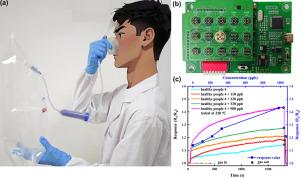基于p-Rh2O3-n-WO3异质结构的化学MEMS丙酮气体传感器用于糖尿病诊断和监测
IF 3.7
1区 化学
Q1 CHEMISTRY, ANALYTICAL
引用次数: 0
摘要
呼吸丙酮是糖尿病的生物标志物,糖尿病患者的呼吸丙酮水平高于健康人,未经治疗的2型糖尿病患者的呼吸丙酮水平也高于对照组。因此,通过分析呼吸中丙酮的浓度,可以诊断糖尿病并监测患者的糖尿病状态。由于mems结构的气体传感器具有超低功耗、小型化和良好的集成能力,更接近实际应用。在此,我们制作了基于p- rh2o3 -n- wo3异质结构的超灵敏mems结构丙酮气体传感器,检测限为110 ppb,功耗为26.5 mW。该传感器具有良好的选择性、响应重复性和长期稳定性。该传感器可以将糖尿病患者的模拟呼吸与健康人的模拟呼吸区分开来。通过对糖尿病患者的模拟呼吸测试,也证实了传感器监测糖尿病患者状态的能力。传感器的超灵敏可归因于p型Rh2O3和n型WO3之间形成p-n异质结以及Rh2O3对丙酮的催化能力。该传感器在糖尿病诊断和糖尿病状态监测方面具有很大的临床应用潜力。本文章由计算机程序翻译,如有差异,请以英文原文为准。


A chemiresistive MEMS acetone gas sensor based on p-Rh2O3-n-WO3 heterostructure for diagnosing diabetes and monitoring diabetic states
Breath acetone is the biomarker of the diabetes as its level is higher in diabetes patients than that in healthy people and also higher in medically untreated type 2 diabetes patients than that in the controlled ones. Therefore, by analysing the concentrations of the acetone in the breaths, the diabetes can be diagnosed and the diabetic state of the patients can be monitored. Due to its merits of ultralow power consumption, miniaturization and good integration ability into the multifunction system, the MEMS-structure gas sensor is more closer to the practical application. Here, we have fabricated an ultrasensitive MEMS-structure acetone gas sensor based on p-RhO-n-WO-heterostructure, with the detection limit of 110 ppb, under the power consumption of 26.5 mW. The sensor also has good selectivity, response repeatability and long-term stability. The sensor can discriminate the simulated breaths of diabetes patients from those of healthy people. The sensor’s capability to monitor the diabetic state of the patients was also confirmed by testing the simulated breaths of the diabetes patients. The ultrasensitivity of the sensor can be ascribed to the formation of the p-n heterojunction between p-type RhO and n-type WO and the catalytic capability of RhO towards acetone. The sensor has a great potential to be applied clinically in the diabetes diagnosis and the diabetic state monitoring.
求助全文
通过发布文献求助,成功后即可免费获取论文全文。
去求助
来源期刊

Sensors and Actuators B: Chemical
工程技术-电化学
CiteScore
14.60
自引率
11.90%
发文量
1776
审稿时长
3.2 months
期刊介绍:
Sensors & Actuators, B: Chemical is an international journal focused on the research and development of chemical transducers. It covers chemical sensors and biosensors, chemical actuators, and analytical microsystems. The journal is interdisciplinary, aiming to publish original works showcasing substantial advancements beyond the current state of the art in these fields, with practical applicability to solving meaningful analytical problems. Review articles are accepted by invitation from an Editor of the journal.
 求助内容:
求助内容: 应助结果提醒方式:
应助结果提醒方式:


